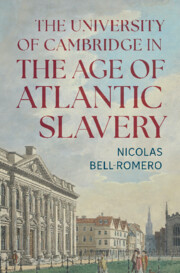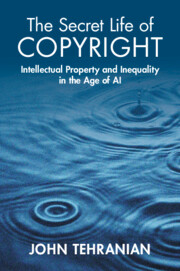Refine search
Actions for selected content:
1373 results
6 - ‘We presume that its influence is nowhere greater than in the Universities’: Ending and Defending American Slavery
-
- Book:
- The University of Cambridge in the Age of Atlantic Slavery
- Published online:
- 12 September 2025
- Print publication:
- 30 October 2025, pp 164-201
-
- Chapter
-
- You have access
- Open access
- HTML
- Export citation
3 - ‘The Glory of their times’: Natural Philosophy, the Law, and the Spoils of Empire
-
- Book:
- The University of Cambridge in the Age of Atlantic Slavery
- Published online:
- 12 September 2025
- Print publication:
- 30 October 2025, pp 76-103
-
- Chapter
-
- You have access
- Open access
- HTML
- Export citation

The University of Cambridge in the Age of Atlantic Slavery
-
- Published online:
- 12 September 2025
- Print publication:
- 30 October 2025
-
- Book
-
- You have access
- Open access
- Export citation
The Racialized Impacts of Confederate Symbols in Public Spaces: The Case of Courthouses
-
- Journal:
- Journal of Race, Ethnicity and Politics , First View
- Published online by Cambridge University Press:
- 12 September 2025, pp. 1-25
-
- Article
-
- You have access
- Open access
- HTML
- Export citation
Chapter 10 - Science
- from Part II - Themes and Issues
-
-
- Book:
- The Cambridge Companion to Modernist Theatre
- Published online:
- 28 August 2025
- Print publication:
- 11 September 2025, pp 180-197
-
- Chapter
- Export citation
Chapter 18 - Igor Stravinsky (and Adorno)
- from Part V - Schoenberg’s Others
-
-
- Book:
- Schoenberg in Context
- Published online:
- 04 September 2025
- Print publication:
- 04 September 2025, pp 186-194
-
- Chapter
- Export citation
Chapter 3 - The Biography of a Face
-
- Book:
- Face and Form
- Published online:
- 21 August 2025
- Print publication:
- 04 September 2025, pp 65-82
-
- Chapter
-
- You have access
- Open access
- HTML
- Export citation
A racial reckoning? racial attitudes in the wake of the murder of George Floyd
-
- Journal:
- Political Science Research and Methods , First View
- Published online by Cambridge University Press:
- 27 August 2025, pp. 1-17
-
- Article
-
- You have access
- Open access
- HTML
- Export citation
11 - Regulating On-Court Tennis Indiscipline
- from Part 2 - Regulatory
-
-
- Book:
- Professional Tennis and Transnational Law
- Published online:
- 07 August 2025
- Print publication:
- 21 August 2025, pp 244-262
-
- Chapter
-
- You have access
- Open access
- HTML
- Export citation
Children and Institutions: US Censuses, Race, Class, and Gender in Puerto Rico’s Institutions for Minors, 1910–1940
-
- Journal:
- Latin American Research Review ,
- Published online by Cambridge University Press:
- 19 August 2025, pp. 1-26
-
- Article
-
- You have access
- Open access
- HTML
- Export citation
A post bellum paradox: net nutrition variation by socioeconomic status, gender and race using 19th and 20th century US prison records
-
- Journal:
- Journal of Biosocial Science / Volume 57 / Issue 4 / July 2025
- Published online by Cambridge University Press:
- 15 August 2025, pp. 460-485
-
- Article
-
- You have access
- Open access
- HTML
- Export citation
Chapter 7 - When Print Was White
-
- Book:
- How the World Became a Book in Shakespeare's England
- Published online:
- 09 August 2025
- Print publication:
- 14 August 2025, pp 234-262
-
- Chapter
- Export citation
2 - Local and Regional Influences in Creating a Pan-African Political Program
-
- Book:
- Building the African Nation
- Published online:
- 25 July 2025
- Print publication:
- 14 August 2025, pp 87-119
-
- Chapter
- Export citation
Introduction
-
- Book:
- The Secret Life of Copyright
- Published online:
- 08 August 2025
- Print publication:
- 14 August 2025, pp 1-23
-
- Chapter
- Export citation

The Secret Life of Copyright
- Intellectual Property and Inequality in the Age of AI
-
- Published online:
- 08 August 2025
- Print publication:
- 14 August 2025
8 - Toxteth 1981
-
- Book:
- Dreams and Songs to Sing
- Published online:
- 07 August 2025
- Print publication:
- 07 August 2025, pp 142-165
-
- Chapter
- Export citation
Chapter 5 - Reading between the Lines
-
-
- Book:
- Antifascism(s) in Latin America and the Caribbean
- Published online:
- 21 July 2025
- Print publication:
- 07 August 2025, pp 107-125
-
- Chapter
- Export citation
Chapter 8 - Our Rights to Ourselves and Others
-
-
- Book:
- Kant's Lectures on Political Philosophy
- Published online:
- 18 July 2025
- Print publication:
- 07 August 2025, pp 142-160
-
- Chapter
- Export citation
Introduction
-
-
- Book:
- Antifascism(s) in Latin America and the Caribbean
- Published online:
- 21 July 2025
- Print publication:
- 07 August 2025, pp 1-22
-
- Chapter
- Export citation
Against American Ethnic Democracy: White Rule and Black Rebellion
-
- Journal:
- Perspectives on Politics , First View
- Published online by Cambridge University Press:
- 07 August 2025, pp. 1-18
-
- Article
-
- You have access
- Open access
- HTML
- Export citation
